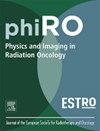利用一种新的o形图像引导放射治疗系统确定双轴旋转动态放射治疗的患者特异性轨迹
IF 3.4
Q2 ONCOLOGY
引用次数: 0
摘要
背景与目的本研究开发了一种使用新型o形直线器的双轴旋转动态放射治疗(BROAD-RT)轨迹搜索方法,旨在识别商业治疗计划系统中患者特异性轨迹。随后,评估其治疗胰腺癌的疗效。材料和方法broad - rt是一种光束传输技术,其中龙门和o形环同时围绕两个轴旋转。生成基于光束眼视图的结构图,然后应用Dijkstra算法探索BROAD-RT以最大限度地减少对RayStation关键器官的辐射剂量。在10例胰腺癌患者中对该方法进行了评估。对于每位患者,创建了两种不同的计划:共面和BROAD-RT轨迹的体积调制弧线治疗(VMAT)计划。不同的轨迹对计划和剂量学指标的影响评估了每一种输送技术。结果共面弹道VMAT (MCSv)和孔径面积(AA) (×103 cm2)的平均调制复杂度评分分别为0.3±0.0和24.8±3.9分,BROAD-RT弹道的平均调制复杂度评分分别为0.4±0.1和35.2±7.1分,其中BROAD-RT弹道的MCSv (p = 5 × 10-5)和AA (p = 0.0002)均显著高于共面弹道。共面和BROAD-RT轨迹之间的剂量差异减少了胃和十二指肠的剂量。我们的研究使用一种新的o形直线器对患者特异性BROAD-RT轨迹进行了自动搜索,并在RayStation中实现了这些轨迹。在具有BROAD-RT轨迹的中剂量区域,剂量分布减小。本文章由计算机程序翻译,如有差异,请以英文原文为准。
Determination of patient-specific trajectory for biaxially rotational dynamic-radiation therapy using a new O-ring-shaped image guided radiotherapy system
Background and purpose
This study developed a trajectory search method for biaxially rotational dynamic-radiation therapy (BROAD-RT) using a new O-ring-shaped linac, aimed at identifying a patient-specific trajectory in a commercial treatment planning system. Subsequently, its efficacy in the treatment of pancreatic cancer was assessed.
Materials and methods
BROAD-RT is a beam delivery technique in which the gantry and O-ring are simultaneously rotated around two axes. A beam’s eye view-based structure map was generated, and the Dijkstra algorithm was then applied to explore the BROAD-RT for minimizing radiation doses to critical organs in RayStation. This procedure was evaluated in 10 patients with pancreatic cancer. For each patient, two different plans were created: volumetric modulated arc therapy (VMAT) plan with coplanar and BROAD-RT trajectory. The effects of different trajectories on the plan and dosimetric indices were assessed for each delivery technique.
Results
The mean modulation complexity score for VMAT (MCSv) and aperture area (AA) (×103 cm2) were 0.3 ± 0.0 and 24.8 ± 3.9 for the coplanar trajectory and 0.4 ± 0.1 and 35.2 ± 7.1 for the BROAD-RT trajectory, respectively, with both MCSv (p = 5 × ) and AA (p = 0.0002) values significantly higher for the BROAD-RT trajectory. Dose difference between the coplanar and BROAD-RT trajectories reduced the dose to the stomach and duodenum.
Conclusions
Our study conducted an automated search for patient-specific BROAD-RT trajectory using a new O-ring-shaped linac and implemented these trajectories in RayStation. Dose distributions were reduced in the intermediate-dose regions with BROAD-RT trajectory.
求助全文
通过发布文献求助,成功后即可免费获取论文全文。
去求助
来源期刊

Physics and Imaging in Radiation Oncology
Physics and Astronomy-Radiation
CiteScore
5.30
自引率
18.90%
发文量
93
审稿时长
6 weeks
 求助内容:
求助内容: 应助结果提醒方式:
应助结果提醒方式:


